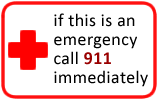Lice - Head
Lice - Head
Does this describe your child's symptoms? |
Click image for more info |
Definition
Symptoms
Lice and Nits
Lifespan of Lice
Cause
Transmission of Head Lice: Live Lice, Not Nits
Return to School
|
If not, see these topics
|
When to Call Your Doctor |
Call Your Doctor Within 24 Hours (between 9 am and 4 pm) If |
|
|
|
Call Your Doctor During Weekday Office Hours If |
|
|
|
Parent Care at Home If |
|
|
HOME CARE ADVICE FOR HEAD LICE |
Reassurance:
Head lice can be treated at home.
With careful treatment, all lice and nits (lice eggs) are usually killed.
There are no lasting problems from having head lice.
They do not carry any diseases.
They do not make your child feel sick.
Nix: Buy Nix anti-lice creme rinse (no prescription needed) and follow package directions.
First, wash the hair with a regular shampoo and towel dry it before using the anti-lice creme. Do NOT use a conditioner or creme rinse after shampooing (Reason: interferes with Nix).
Pour 2 ounces (full bottle or 60 ml) of Nix into damp hair. People with long hair may need to use 2 bottles.
Work the creme into all the hair down to the roots.
If necessary, add a little warm water to work up a lather.
Nix is safe above 2 months old.
Leave the shampoo on for a full 10 minutes or it won't kill all the lice. Then rinse the hair thoroughly with water and dry it with a towel.
REPEAT the anti-lice shampoo in 9 days to kill any nits that survived.
Remove the Dead Nits:
Only live lice can transmit lice to another child.
Nits (lice eggs) do not transmit lice.
Most treated nits (lice eggs) are dead after the first treatment with Nix. The others will be killed with the 2nd treatment in 9 days.
Removing the dead nits is helpful for esthetic reasons and so other people won't think your child still has untreated lice.
Nits can be removed by backcombing with a special nit comb or pulling them out individually. This is time-consuming.
Wetting the hair makes removal easier, but avoid any products that claim they loosen the nits. (Reason: They can interfere with the ability of Nix to stay on the hair and keep working.)
Nit removal is not urgent and should not interfere with the return to school.
Some schools, however, have a no-nit policy and will not allow children to return if nits are visible. The American Academy of Pediatrics and the National Association of School Nurses recommend that all no-nit policies be abandoned. If your child's school has a no-nit policy, your child's doctor may be able to help.
Hairwashing Precautions to Help Nix Work:
Don't wash the hair with shampoo until 2 days after lice treatment
Avoid hair conditioners before treatment and for 2 weeks afterwards (Reason: coats the hair and interferes with Nix)
Contagiousness of Lice/ Return to School:
Lice are transmitted by close contact (they cannot jump or fly).
Your child can return to child care or school after 1 treatment with the anti-lice shampoo.
Check the heads of everyone else living in your home. If lice or nits are seen, or someone has the new onset of an itchy scalp rash, they also should be treated with anti-lice shampoo.
Bedmates of children with lice should also be treated. If in doubt, have your child examined for lice.
Re-emphasize not sharing combs and hats.
Also notify the school nurse or child care center director so she can check other students in your child's class/center.
Cleaning the House:
Lice that are off the body rarely cause reinfection. (Reason: lice can't live for over 24 hours off the human body.) Just vacuum your child's room.
Soak hair brushes for 1 hour in a solution containing some anti-lice shampoo.
Wash your child's sheets, blankets, pillow cases, and any clothes worn in the past 2 days in hot water (130° F or 54° C) kills lice and nits.
Optional step (probably not necessary): Items that can't be washed (e.g., hats, coats, or scarves) should be set aside in sealed plastic bags for 2 weeks (the longest period that nits can survive).
Expected Course:
With treatment, all lice and nits should be killed.
A recurrence usually means another contact with an infected person, the shampoo wasn't left on for 10 minutes, hair conditioner was used or the treatment wasn't repeated in 9 days.
Call Your Doctor If:
New lice or nits appear in the hair
Scalp rash or itch lasts over 1 week after the anti-lice shampoo
Sores on scalp start to spread or look infected
Your child becomes worse
Extra Care Advice - Cetaphil Cleanser for Nix Treatment Failures:
Go to your drugstore and buy Cetaphil cleanser (no prescription needed) in the soap department. It works by coating the lice and suffocating them.
Apply the Cetaphil cleanser throughout the scalp to dry hair.
After all the hair is wet, wait 2 minutes for Cetaphil to soak in.
Comb out as much excess cleanser as possible.
Blow dry your child's hair. It has to be thoroughly dry down to the scalp to suffocate the lice. Expect this to take 3 times longer then it would if the hair was just wet with water.
The dried Cetaphil will smother the lice. Leave it on your child's hair for at least 8 hours.
In the morning, wash off the Cetaphil with a regular shampoo.
To cure your child of lice, REPEAT this process twice in 1 and 2 weeks.
The cure rate can be 97%.
Detailed instructions are available online: www.nuvoforheadlice.com
And remember, contact your doctor if your child develops any of the "Call Your Doctor" symptoms.
Updated:
March 22, 2017






